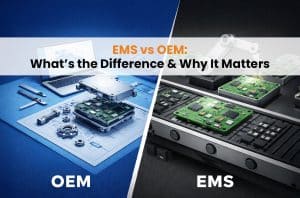Electronics industry production is undergoing a deep transformation in 2025 due to rapid technological alternations, transformations in market forces, and assumptions regarding environmental standards. Here are the chief seven trends reshaping the electronic manufacturing services arena this year.
1. AI-Powered Manufacturing and Predictive Analytic
At present, artificial intelligence is core to electronics manufacturing processes. In 2025, several manufacturers leverage AI-enabled predictive analytics to predict equipment failure and thus reduce downtime, while optimizing production lines in real-time.
2. Automation and Intelligent Robotics
Had automation been monotony before, not anymore. The new-age automation in PCB assembly, component placement, and inspection increases precision and speed in these operations, while robotic process automation (RPA), industrial IOT, and machine vision systems cooperate.
3. Sustainable Manufacturing Practices
EMS manufacturing is adopting eco-design principles, the use of biodegradable materials, and closed-loop recycling approaches. Empowered by regulations and spirited by environmentalist or public interest groups, systems are now in place for advanced energy efficiency technologies, water conservation technologies, and carbon-neutrally balanced supply chains.
4. Advanced Packaging and Miniaturization
With the need growing for smaller, more performing electronics, especially in wearable systems, automotive systems, and medical devices, usage of advanced packaging and integration methods such as System-in-Package (SiP) and 3D IC is picking up. These processes increase functionality in decreased sizes with concomitant improvements in thermal management and electrical performance.
5. Global Supply Chain Reconfiguration
Geopolitical changes, increased logistics costs, and resilience demands for supply chains push manufacturers to review their procurement strategies. Hence, nearshoring and regional manufacturing clusters will be on the rise in 2025.
6. Cybersecurity Integration in Manufacturing Operations
EMS Companies In India, while going more and more digital, cyber threats have also increased in number. Cybersecurity is thus being integrated by the manufacturers at the operational technology (OT) levels, with network segmentation, threat detection systems, and secure firmware updates being rolled out so as to protect intellectual property (IP), equipment, and customer data.
7. Human-Centric Smart Factories
While there is always the push for automation, the workforce is still very important. The factories of the year 2025 thus revolve around creating environments conducive to human-machine collaboration. For instance, augmented reality-based systems and applications deliver training and technical support that is hands-free, while digital workstations promote ergonomic design and increase productivity.


